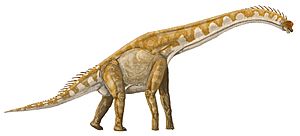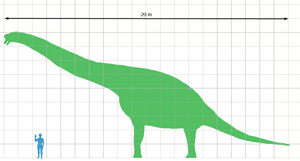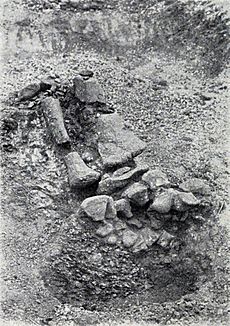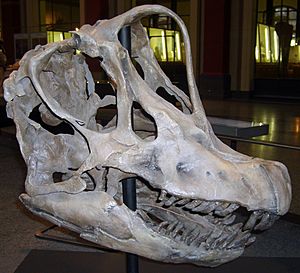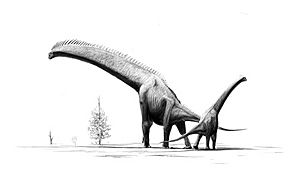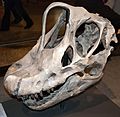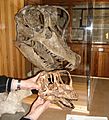Giraffatitan facts for kids
Quick facts for kids GiraffatitanTemporal range: Upper Jurassic
150–145 mya |
|
|---|---|
 |
|
| Skeleton on display in the Museum für Naturkunde Berlin, Germany | |
| Scientific classification | |
| Kingdom: | |
| Class: | |
| Superorder: | |
| Order: | |
| Infraorder: | |
| Family: | |
| Genus: |
†Giraffatitan
|
Giraffatitan ("giraffe titan") is a genus of sauropod dinosaurs which lived during the Upper Jurassic, about 140 million years ago. It was related to Brachiosaurus, and was one of the largest animals known to have walked the earth.
Giraffatitans were about 23-metre (75 ft) long and weighed about 40 tonnes (88,000 lb). They had very long necks and were well adapted for feeding on the tall conifers which were the main trees in the Jurassic forests. They lived in what is now Tanzania.
It was first named as an African species of Brachiosaurus (B. brancai) in 1914. In 1991, George Olshevsky said there were enough differences to make its own genus, creating Giraffatitan.
Contents
Description
Giraffatitan was a sauropod, one of a group of four-legged, plant-eating dinosaurs with long necks and tails and relatively small brains. It had a giraffe-like build, with long forelimbs and a very long neck. The skull had a tall arch anterior to the eyes, consisting of the bony nares, a number of other openings, and "spatulate" teeth (resembling chisels). The first toe on its front foot and the first three toes on its hind feet were clawed.
The placement of Giraffatitan nostrils has been the source of much debate with Witmer (2001) describing in Science the hypothesized position of the fleshy nostrils in Giraffatitan in as many as five possible locations. Comparing the nares of dinosaurs with those of modern animals, he found that all species have their external nostril openings in the front, and that sauropods like Giraffatitan did not have nostrils on top of their heads, but near their snouts. There has also been the hypothesis of various sauropods, such as Giraffatitan, possessing a trunk. The fact that there were no narrow-snouted sauropods (Giraffatitan included) tends to discredit such a hypothesis. Stronger evidence for the absence of a trunk is found in the teeth wear of Giraffatitan, which shows the kind of wear that would result from biting and tearing off of plant matter rather than purely grinding, which would be the result of having already ripped the leaves and branches off with its trunk.
Size
For many decades, Giraffatitan was claimed to be the largest dinosaur known, (ignoring the possibly larger but lost Amphicoelias) but in the later part of the 20th century several giant titanosaurians appear to have surpassed Giraffatitan in terms of sheer mass. However, Giraffatitan, along with Brachiosaurus are still the largest dinosaurs known from relatively complete material.
All size estimates for Giraffatitan are based on the specimen HMN SII, a subadult individual between 21.8–22.5 metres (72–74 ft) in length and about 12 meters (39 ft) tall. Mass estimates are more problematic but estimates based on models reconstructed from bone volume measurements, which take into account the extensive, weight-reducing air sac systems present in sauropods, and estimated muscle mass, are in the range of 23.3–39.5 tonnes (25.7–43.5 short tons).
History and classification
Giraffatitan brancai was first named and described by German paleontologist Werner Janensch in 1914 as Brachiosaurus brancai, based on several specimens recovered between 1909 and 1912 from the Tendaguru formation near Lindi, in what was then German East Africa, today Tanzania. It is known from five partial skeletons, including three skulls and numerous fragmentary remains including skull material, some limb bones, vertebrae and teeth. It lived from 145 to 150 million years ago, during the Kimmeridgian to Tithonian ages of the Late Jurassic period.
A famous specimen of Giraffatitan brancai mounted in the Berlin's Natural History Museum is one of the largest, and in fact the tallest, mounted skeletons in the world, as certified by the Guinness Book of Records. Beginning in 1909, Werner Janensch found many additional G. brancai specimens in Tanzania, Africa, including some nearly complete skeletons, and used them to create the composite mounted skeleton seen today.
Paleobiology
The nostrils of Giraffatitan, like the huge corresponding nasal openings in its skull, were long thought to be located on the top of the head. In past decades, scientists theorized that the animal used its nostrils like a snorkel, spending most of its time submerged in water in order to support its great mass. The current consensus view, however, is that Giraffatitan was a fully terrestrial animal. Studies have demonstrated that water pressure would have prevented the animal from breathing effectively while submerged and that its feet were too narrow for efficient aquatic use. Furthermore, new studies by Lawrence Witmer (2001) show that, while the nasal openings in the skull were placed high above the eyes, the nostrils would still have been close to the tip of the snout (a study which also lends support to the idea that the tall "crests" of brachiosaurs supported some sort of fleshy resonating chamber).
Brain
Giraffatitan's brain measured about 300 cm³, which, like those of other sauropods, was small compared to its massive body size. A 2009 study calculated its Encephalization Quotient (a rough estimate of possible intelligence) at a low 0.62 or 0.79, depending on the size estimate used. Like other sauropods, Giraffatitan has a sacral enlargement above the hip which some older sources misleadingly referred to as a "second brain". However, glycogen bodies are a more likely explanation.
Metabolism
If Giraffatitan was endothermic (warm-blooded), it would have taken an estimated ten years to reach full size, if it were instead poikilothermic (cold-blooded), then it would have required over 100 years to reach full size. As a warm-blooded animal, the daily energy demands of Giraffatitan would have been enormous; it would probably have needed to eat more than ~182 kg (400 lb) of food per day. If Giraffatitan was fully cold-blooded or was a passive bulk endotherm, it would have needed far less food to meet its daily energy needs. Some scientists have proposed that large dinosaurs like Giraffatitan were gigantotherms. Internal organs of these giant sauropods were probably enormous.
Images for kids
-
Authentic Giraffatitan skull (behind), compared to that of the small brachiosaur Europasaurus
-
The feeding range of Giraffatitan (left) and Sauroposeidon
See also
 In Spanish: Giraffatitan brancai para niños
In Spanish: Giraffatitan brancai para niños


